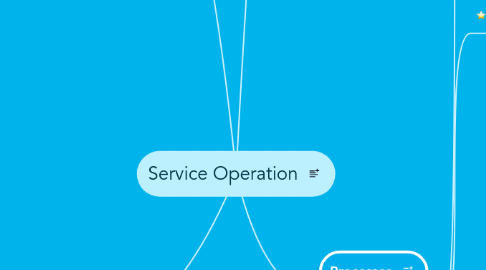
1. The Role of Communication
1.1. Effectively Communication practice
1.1.1. Identify the relevant stakeholders
1.1.2. Types of communication typical
1.1.2.1. routine operational communication
1.1.2.2. communication between shifts
1.1.2.3. performance reporting
1.1.2.4. communication in projects
1.1.2.5. training on new or changed processes and service designs
1.1.2.6. Communicate Changes
1.1.2.7. Communicate exceptions
1.1.2.8. Communicate emergencies
1.1.2.9. Communicate on strategy, design, and transition to SO team
1.1.3. Express the intended purpose
1.1.4. Agree on an appropriate mode of communication
1.2. Facilities successful meetings
1.2.1. the factors drive to a successful meeting
1.2.1.1. Establishing a clear agenda
1.2.1.2. recording issues that are not on the current agenda
1.2.1.3. ensuring that rules for particular are understood
1.2.1.4. Keeping minutes
1.2.1.5. Encouraging appropriate levels of participation
1.3. Common SO meetings
1.3.1. Operations meetings
1.3.2. Group meetingd
1.3.3. Customer meetings
2. Scope and Responsibilities
2.1. Scopes
2.1.1. Services
2.1.2. Service Management processes
2.1.3. Technology
2.1.4. People
2.2. Responsibilities
2.2.1. Executing and performing processes to optimize the cost and quality of services
2.2.2. Provide the business with capacity to meet its objectives
2.2.3. Technology used to deliver and support service
2.2.4. The overall functioning of the business ifself
2.2.5. Ensuring user satisfaction with the IT services
2.3. Goals
2.3.1. Deliver IT services and support
2.3.2. Ensure IT services are provided only to those authorized to receive the service
2.3.3. Reduce the impact of service outages in daily operations
3. SO Functions
3.1. Service Desk
3.1.1. Benefits
3.1.1.1. Improves customer service
3.1.1.2. Increases accessibility through a single point of contact
3.1.1.3. Improves infrastructure and control
3.1.1.4. Improves the use of IT support resources
3.1.1.5. reduces the negative business impact
3.1.1.6. provides an excellent grounding for employees
3.1.2. Structures
3.1.2.1. Local
3.1.2.2. Centralized
3.1.2.3. Virtual service desk
3.1.2.4. Follow-the-sun service desk
3.2. Technical Management
3.2.1. Focuses on the management of IT hardware. It plays a dual role
3.2.1.1. holds technical knowledge and expertise
3.2.1.2. provides technical resources to support ITSM lifecycle
3.2.2. The roles
3.3. IT Operations Management
3.3.1. Operations Control sub-funtion
3.3.1.1. Executing routine tasks in all technical areas
3.3.1.2. managing consoles
3.3.1.3. job scheduling
3.3.1.4. Performing backups & restores
3.3.1.5. Managing print & electronic output
3.3.1.6. Performing maintenance activities
3.3.2. Facilities Management sub-function
3.3.3. plays a dual role
3.3.3.1. keeping current activities and processes running optimal
3.3.3.2. adapting to changes in business requirements and demand
3.4. Application Management
3.4.1. plays a dual role
3.4.1.1. technical knowledge and expertise
3.4.1.2. resources needed to support the ITSM lifecycle
3.4.2. Specific roles
3.4.2.1. providing guidance to IT SO
3.4.2.2. integrating the application management lifecycle with each stage of the ITSm
4. Processes
4.1. Incident Management
4.1.1. Scopes & Principles
4.1.1.1. Scopes
4.1.1.2. Principles
4.1.1.2.1. Setting timescales for incident response
4.1.1.2.2. Creating incident models
4.1.1.2.3. planning special responses to major incidents
4.1.1.2.4. Tracking incident status
4.1.1.2.5. dividing the incident life-cycle in to clear stages
4.1.2. Activities of SO Process
4.1.2.1. incident identification
4.1.2.2. Incident logging
4.1.2.2.1. category and impact
4.1.2.2.2. nature and occurrence
4.1.2.2.3. resolution
4.1.2.3. Incident categorization
4.1.2.3.1. To develop appropriate set of incident categories
4.1.2.4. Incident prioritization
4.1.2.5. incident diagnosis
4.1.2.6. Incident escalation
4.1.2.6.1. Functional escalation
4.1.2.6.2. Heirarchic escalation
4.1.2.7. Investigation and diagnosis
4.1.2.7.1. investigating is likely to involve
4.1.2.8. Resolution and recovery
4.1.2.8.1. People may be involve: users, service desk staff, members of support groups, third-party suppliers
4.1.2.9. incident closure / re-opening
4.1.2.9.1. Confirm before closed
4.1.3. Managing Incidents
4.1.4. Incidents Interface
4.1.4.1. Service Design stage
4.1.4.1.1. SLM, Service Level Management
4.1.4.1.2. ISM, Information Security Management
4.1.4.1.3. CM, Capacity Management
4.1.4.1.4. AM, Availability Management
4.1.4.2. Service Transition stage
4.1.4.2.1. SACM, Service Asset and Configuration Management
4.1.4.2.2. CM, Change Management
4.2. Problem Management
4.2.1. Scopes
4.2.1.1. Diagnosing the root causes of INC and determining resolutions
4.2.1.1.1. Involve appropriate control procedures, especially Change Management and Release and Deployment Management
4.2.1.2. Maintaining and documenting information
4.2.1.3. Conducting periodic scheduled review of INC records to find patterns and trends
4.2.1.4. Conducting major INC reviews
4.2.1.5. Conducting periodic scheduled review of operational log and maintenance records to identify patterns and trends in activities
4.2.1.6. Conducting periodic scheduled review of event logs to identify patterns and trends
4.2.1.7. Conducting brainstorming sessions to identify trens
4.2.1.8. Using check sheets to collect data on service or operational quality issues
4.2.2. Principles
4.2.2.1. Reactive and proactive
4.2.2.2. Problem models
4.2.2.2.1. Problem models and workarounds for know errors should be recorded in a Known Error Database, KEDB
4.2.2.3. Incidents versus problems
4.2.3. Objectives
4.2.3.1. Prevent
4.2.3.2. Eliminate
4.2.3.3. Minimize
4.2.4. Processes
4.2.4.1. 1. Problem Detection
4.2.4.1.1. Reactively
4.2.4.1.2. Proactively
4.2.4.2. 2. Problem logging
4.2.4.2.1. reported by
4.2.4.2.2. date and time
4.2.4.2.3. service and equipment details
4.2.4.2.4. priority and categorization details
4.2.4.2.5. incident record information
4.2.4.2.6. Diagnostic or attempted recovery
4.2.4.3. 3. Problem catageorization
4.2.4.4. 4. Problem prioritization
4.2.4.5. 5. Problem investigation & diagnosis
4.2.4.5.1. Techniques can be used to investigate and diagnose
4.2.4.5.2. use the KEDB
4.2.4.5.3. use the CMS
4.2.4.6. 6. Workarounds
4.2.4.7. 7. Raise know error if required
4.2.4.8. 8. Problem resolution
4.2.4.9. 9. Problem closure
4.2.4.10. 10. Major problem review
4.2.5. Interface
4.2.5.1. Service Strategy
4.2.5.1.1. Financial Management
4.2.5.2. Service design
4.2.5.2.1. Availability Management
4.2.5.2.2. Capacity Management
4.2.5.2.3. IT Service Continuity Management
4.2.5.2.4. Service Level Management, SLM
4.2.5.3. Service Transition
4.2.5.3.1. Change Management
4.2.5.3.2. SACM, Service Asset and Configuration Management
4.2.5.3.3. Knowledge Management
4.2.5.3.4. Release and Deployment Management
4.2.5.4. CSI
4.3. Event Management
4.3.1. objectives
4.3.1.1. Detect all changes of state
4.3.1.2. determine the appropriate control action
4.3.1.3. provide the trigger, or entry point, for the excution
4.3.1.4. provide the means to compare actual operating performance and behavior against design standards and SLAs
4.3.1.5. provide a basic for service assurance and reporting
4.3.2. Associating with
4.3.2.1. CIs
4.3.2.2. environmental conditions
4.3.2.3. software licensing
4.3.2.4. security
4.3.2.5. normal IT activity
4.4. Request Fulfillment
4.4.1. objectives
4.4.1.1. maintain user and customer satisfaction
4.4.1.2. provide a channel for users to request and receive standard services
4.4.1.3. Provide information to users and customer
4.4.1.4. source and deliver the component of requested standard services
4.4.1.5. assist users
